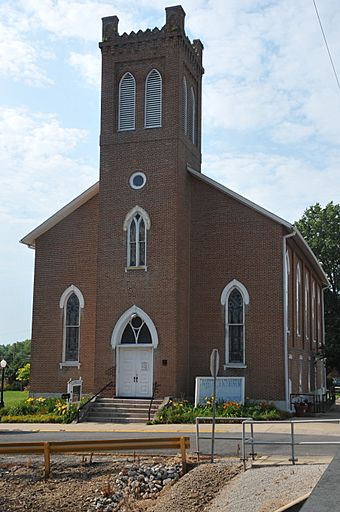First Presbyterian Church (Vandalia, Illinois) facts for kids
Quick facts for kids |
|
|
First Presbyterian Church
|
|

Front of the church
|
|
| Location | 301 W. Main St., Vandalia, Illinois |
|---|---|
| Area | less than one acre |
| Built | 1868 |
| Architectural style | Gothic Revival |
| NRHP reference No. | 82002534 |
| Added to NRHP | March 24, 1982 |
The First Presbyterian Church is a very old building in Vandalia, Illinois. It used to be a church, but now it is a museum. You can find it at 301 W. Main Street. This building stands on a spot that has been important for a long time.
A Historic Building in Illinois
The church building we see today was built in 1868. But even before that, another important building stood here. In 1823, the first Protestant church in Illinois was built on this very spot. It was called the House of Divine Worship.
At that time, Vandalia was the capital city of Illinois. The state government even helped build the first church! The governor's house was right next door. This shows how important the location was.
From Church to Museum
The Presbyterian church was built after Vandalia was no longer the state capital. The capital had moved to Springfield. The church was designed in a style called Gothic Revival. This style looks a bit like old European castles and cathedrals.
The church is made of red brick. It has a tall bell tower that reaches about 60 feet high. Look closely, and you will see twelve special windows. They are called Gothic pointed arch windows. Each window has beautiful stained glass with religious pictures.
The Presbyterian church congregation used this building for many years. But in the 1960s, they moved to a new church. Since then, this historic building has become the Fayette County Museum. It helps people learn about the history of the area.
A Place in History
This special building was added to the National Register of Historic Places on March 24, 1982. This means it is recognized as an important historical site in the United States. It is one of only four places in Fayette County that are on this national list.



